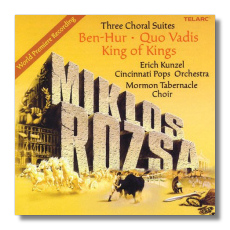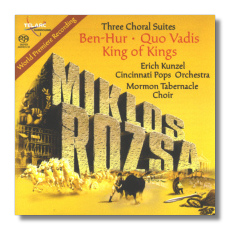
The Internet's Premier Classical Music Source
Related Links
- Rózsa Reviews
- Latest Reviews
- More Reviews
-
By Composer
-
Collections
DVD & Blu-ray
Books
Concert Reviews
Articles/Interviews
Software
Audio
Search Amazon
Recommended Links
Site News
 CD Review
CD Review
Miklós Rózsa

Three Choral Suites
- Ben-Hur
- Quo Vadis
- King of Kings
Mormon Tabernacle Choir/Craig Jessop
Cincinnati Pops Orchestra/Erich Kunzel
Telarc CD-80631 DDD 61:54
Also released on Hybrid Multichannel SACD SACD-60631:
Amazon
- UK
- Germany
- Canada
- France
- Japan
- ArkivMusic
- CD Universe
- JPC
Summary for the Busy Executive: Super-Technicolor Wow! Cue God.
The brilliant film composer Miklós Rózsa, unlike so many of his colleagues, also happened to be a marvelous composer of concert and chamber music. In fact, I find myself wishing that he had written more of the latter. He didn't do so because film music paid the bills. We should probably give thanks that he wrote as many "absolute" scores as he did, since they represented acts of pure idealism. Sometimes, you gets what you pays for. Still, much really good music lies buried in his film scores, and Rózsa did what he could to salvage some of it in orchestral suites like Background to Violence and his arrangements of cues from Lust for Life, The Jungle Book, Ben-Hur, El Cid, and King of Kings.
Apparently, Rózsa had planned to extract "choral" suites (ie, suites with some of the movements calling for chorus) from his "epic" trilogy – Quo Vadis, Ben-Hur, and King of Kings – but died before he could get underway. However, friends and colleagues did it for him, including his musical assistant, the late Christopher Palmer, always eager to get the composer's film music into the concert hall.
For those of you wondering, these suites differ in part from earlier incarnations. The Ben-Hur prelude, for example, proclaims the familiar opening "Roman" fanfare, but minus the alleluias, and it soon moves off in a different direction than on the official soundtrack. There are many reasons for the changes, chief among them, the nature of most movie music. With very rare exceptions, a film's music "cue" lasts no more than seconds. Many directors distrust extended music sequences, very often because they feel that the audience will grow antsy if the actors aren't speaking. Very few had the genius for using long set-pieces of music found in the films of, say, Hitchcock, Chaplin, Eisenstein, Clair, or Lubitsch, who, significantly, I think, all come from the silent era and tend to favor the image and montage over dialogue. Consequently, most arrangements of film music consist of splicing together separate cues, and, of course, one can sequence these in many ways.
Two of the pictures, at any rate, are pseudo-Biblical kitsch, with Quo Vadis so over the top, both in story and performances, that it crosses over into outrageous camp. They're how the Holy Spirit would have written the Gospels, if he had wanted to pitch them to a Hollywood producer. One suspects that most of the movie audience can't take the Gospels straight. King of Kings, after all, did the least well financially, and they had to reshoot the Crucifixion when preview audiences objected to a Jesus (a Nordic Jesus, at that!) with hair on his chest. Rózsa's score is just about the only thing worth seeing the movie for, and even Rózsa is at times infected by a piety-on-steroids mentality. Of the three films, Ben-Hur and King of Kings are, despite occasional melodramatic lapses of taste almost endemic to the genre, quite interesting. The original novel Ben-Hur is helped a great deal by the movie script, which becomes the story of a man on the edge of great events who ignores them through obsession with his own agenda. The homoerotic undercurrent between hero and villain is also very well done and provides a reasonable motive for the villain's actions (a spurned lover) without becoming preachy. King of Kings comes off less well as a whole, but there are wonderful moments: Robert Ryan as John the Baptist in the confrontation with Herod and Salome; Hurd Hatfield's reptilian Pilate; Jeffrey Hunter as the blond, blue-eyed Jesus, doing pretty well in an ungrateful part. The movie's also beautifully shot.
The question comes down to, if you have the soundtrack albums already, whether you need these. In general, I prefer soundtrack albums to snippets, and I can recommend almost without reservation the ones for Ben-Hur and Quo Vadis (both on Dutton Labs Vocalion CDLK4332, 2 CDs) and King of Kings (Rhino 78348, also 2 CDs). For one thing, you get more context for the music, as well as more music. On the other hand, it's four CDs for the three movies.
Kunzel, a conductor I admire, nevertheless turns in an oddly flat reading of the choral suites. Just about everything is pitched to jerk the knee or wring the heart. The galley-slave sequence in Ben-Hur, for example, is a study in quickening and crescendo. There are actually three tempi in the score, corresponding to cruise, faster, and ramming speed. Kunzel gets too loud and too fast too quickly, so that we experience only two tempi, the latter for most of the movement. Rózsa himself does much better and in general brings more shade and subtlety into scores that warily toe the line of bombastic anyway. After a while, Kunzel's performance is just too rich, like eating a whole jar of marshmallow cream at one go all by yourself. I should add, however, that heard separately, the suites fare much better.
I normally don't say much about sound quality, but Telarc's engineering really bothered me. The choir and the orchestra sounded as if they were recorded in different rooms, with the orchestra in a far brighter acoustic. I checked the notes and – lo, and behold! (to coin a phrase) – that's exactly what Telarc did. After all, the company couldn't reasonably recoup the cost of transporting, feeding, and housing a symphony orchestra or a mega-choir. Even so, the engineers – especially Telarc engineers, with their reputation for high sound quality – should have taken more care. The Mormon Tabernacle Choir – a choral behemoth – needs absolutely no help to produce a rich, full sound. With what I hear as a goosed bass, their tone is like a heavy, gloppy sauce over a nice piece of fish.
I can't deny that the CD is a lot of fun. It provides a nice wallow, but it strikes me that you can find better alternatives.
Copyright © 2007, Steve Schwartz






















